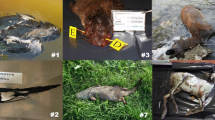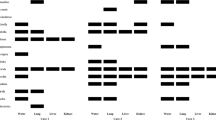Abstract
The search for diatoms is the test that most of all may contribute to the forensic diagnosis of drowning. Diatoms can be extracted through different methods, which are all complex and long. In this preliminary study, we assessed human vitreous humor as an innovative substrate on which to research diatoms. Sampling and analyses were performed on 3 groups of 10 corpses each. The first one was composed of drowned victims. The second one of victims of traffic accidents with subsequent projection in water; based on the severe traumatic injuries reported at autopsy, we considered such victims as ideally assimilable to bodies immersed in water postmortem. The third group was composed of subjects who died for natural causes and without any relationship with water. The vitreous humor was centrifugated and cytocentrifuged and spotted on two different histological slides: one was left blank and the other one was assessed with hematoxylin and eosin staining. Microscopic observation successfully revealed diatoms in all cases of the first group; in the second group diatoms were not detected in 6 cases; in the third group, no diatoms at all were observed. Diatoms were always qualitatively and quantitatively consistent with those found in the corresponding viscera and waters, which had been investigated through classical acid digestion. Our analyses have demonstrated that the vitreous humor behaves in a completely similar way to the other viscera in cases of drowning. Although further investigations are necessary, vitreous humor has proved to be an innovative, suitable, and reliable substrate for the forensic research of diatoms.



Similar content being viewed by others
Data availability
All the data have been reported in the manuscript.
Code availability
Not applicable.
References
Knight B, Saukko P (2004) Immersion deaths. In: Knight B, Saukko P (eds) Knight’s forensic pathology, 3rd edn. E Arnold, London, pp 395–411
Stephenson L, Van den Heuvel C, Byard RW (2019) The persistent problem of drowning - a difficult diagnosis with inconclusive tests. J Forensic Leg Med 66:79–85. https://doi.org/10.1016/j.jflm.2019.06.003
Jian JQ, Liu NG, Chen YJ (2019) Research progress in virtopsy of drowning. Fa Yi Xue Za Zhi 35:328–331. https://doi.org/10.12116/j.issn.1004-5619.2019.03.013
Rácz E, Könczöl F, Tóth D, Patonai Z, Porpáczy Z, Kozma Z, Poór VS, Sipos K (2016) PCR-based identification of drowning: four case reports. Int J Legal Med 130:1303–1307. https://doi.org/10.1007/s00414-016-1359-7
Lorin de la Grandmaison G, Paraire F (2003) Place of pathology in the forensic diagnosis of drowning. Ann Pathol 23:400–407
Piette MH, De Letter EA (2006) Drowning: still a difficult autopsy diagnosis. Forensic Sci Int 163:1–9. https://doi.org/10.1016/j.forsciint.2004.10.027
Krstic S, Duma A, Janevska B, Levkov Z, Nikolova K, Noveska M (2002) Diatoms in forensic expertise of drowning – a Macedonian experience. Forensic Sci Int 127:198–203. https://doi.org/10.1016/s0379-0738(02)00125-1
Ludes B, Coste M, Tracqui A, Mangin P (1996) Continuous river monitoring of the diatoms in the diagnosis of drowning. J Forensic Sci 41:425–428
Pollanen MS, Cheung C, Chiasson DA (1997) The diagnostic value of the diatom test for drowning, I. Utility: a retrospective analysis of 771 cases of drowning in Ontario, Canada. J Forensic Sci 42:281–285
Muccino E, Crudele GD, Gentile G, Marchesi M, Rancati A, Zoja R (2015) Suicide drowning in the non-coastal territory of Milan. Int J Legal Med 129:777–784. https://doi.org/10.1007/s00414-014-1115-9
Hürlimann J, Feer P, Elber F, Niederberger K, Dirnhofer R, Wyler D (2000) Diatom detection in the diagnosis of death by drowning. Int J Legal Med 114:6–14. https://doi.org/10.1007/s004149900122
Takeichi T, Kitamura O (2009) Detection of diatom in formalin-fixed tissue by proteinase K digestion. Forensic Sci Int 190:19–23. https://doi.org/10.1016/j.forsciint.2009.05.005
Yang YF, Cheng C, Wang Z, Lin YY, Lin F, Ma XF, Chen H (2009) Improved nitric acid digestion method for detecting diatom in autopsy tissue. Fa Yi Xue Za Zhi 25:40–41
Sidari L, Di Nunno N, Costantinides F, Melato M (1999) Diatom test with Soluene-350 to diagnose drowning in sea water. Forensic Sci Int 103:61–65. https://doi.org/10.1016/s0379-0738(99)00056-0
Marezza F, Marchetti C, Lanzi G, Lusetti A, Bertani A, Cecchi R (2021) Diatom extraction: a new technique with heated H2O2 A technical note. Leg Med 50:101861. https://doi.org/10.1016/j.legalmed.2021.101861
Cala AD, Vilain R, Tse R (2013) Elevated postmortem vitreous sodium and chloride levels distinguish saltwater drowning (SWD) deaths from immersion deaths not related to drowning but recovered from saltwater (DNRD). Am J Forensic Med Pathol 34:133–138. https://doi.org/10.1097/PAF.0b013e3182868ee1
Byard RW, Summersides G (2011) Vitreous humor sodium levels in immersion deaths. J Forensic Sci 56:643–644. https://doi.org/10.1111/j.1556-4029.2011.01735.x
Garland J, Tse R, Oldmeadow C, Attia J, Anne S, Cala AD (2016) Elevation of post mortem vitreous humour sodium and chloride levels can be used as a reliable test in cases of suspected salt water drowning when the immersion times are less than one hour. Forensic Sci Int 266:338–342. https://doi.org/10.1016/j.forsciint.2016.06.001
Tse R, Kuo TC, Kesha K, Garland J, Garland S, Anne S, Elstub H, Cala A (2017) Postmortem vitreous humor magnesium does not elevate in salt water drowning when the immersion time is less than an hour. Am J Forensic Med Pathol 38:298–303. https://doi.org/10.1097/PAF.0000000000000351
Pigaiani N, Bertaso A, De Palo EF, Bortolotti F, Tagliaro F (2020) Vitreous humor endogenous compounds analysis for post-mortem forensic investigation. Forensic Sci Int 310:110235. https://doi.org/10.1016/j.forsciint.2020.110235
Belsey SL, Flanagan RJ (2016) Postmortem biochemistry: current applications. J Forensic Leg Med 41:49–57. https://doi.org/10.1016/j.jflm.2016.04.011
Streble H, Krauter D (2002) Diatomee. In: Streble H, Krauter D (eds) Atlante dei microrganismi acquatici - La vita in una goccia d’acqua. F. Muzzio & C. Editore, Padova, pp 132–143
Ludes B, Coste M (1996) Diatomées et médecine légale. Technique et Documentation. Lavoisier Editions Medicales Internationale, Paris
Pollanen MS (1998) Forensic diatomology and drowning. Elsevier, Amsterdam
Lunetta P (2005) Bodies found in water, epidemiological and medico-legal issues. Dissertation, University of Helsinki
Author information
Authors and Affiliations
Contributions
TS and GG equally contributed to this work. They devised the project and the main conceptual idea of the article, collected data, drafted the manuscript, and performed literature research. BP contributed to the samples collection and review and editing. SA contributed to the investigation and methodology. RZ guarantor of the project and directed the study, devised the main conceptual idea of the article.
Corresponding author
Ethics declarations
Ethics approval
This study was performed from data from human cadavers. This article does not contain any studies with (living) human participants or animals performed by any of the authors. The subjects involved in this study underwent a judicial autopsy at the Institute of Legal Medicine of Milan in order to identify the cause of death. Data collecting, sampling, and subsequent forensic analysis were authorized by the public prosecutor. Therefore, data were acquired as part of a forensic judicial investigation and in accordance to Italian Police Mortuary Regulation.
Consent to participate
The authors declared that all the investigations were carried out accordingly to the Italian Law.
Consent for publication
All the authors agree for publication.
Conflict of interest
The authors declare no competing interests.
Additional information
Publisher's note
Springer Nature remains neutral with regard to jurisdictional claims in published maps and institutional affiliations.
Stefano Tambuzzi and Guendalina Gentile are co-first authors.
Rights and permissions
About this article
Cite this article
Tambuzzi, S., Gentile, G., Bailo, P. et al. Use of cadaveric vitreous humor as an innovative substrate for diatoms research and forensic diagnosis of drowning. Int J Legal Med 136, 1745–1754 (2022). https://doi.org/10.1007/s00414-021-02759-w
Received:
Accepted:
Published:
Issue Date:
DOI: https://doi.org/10.1007/s00414-021-02759-w




